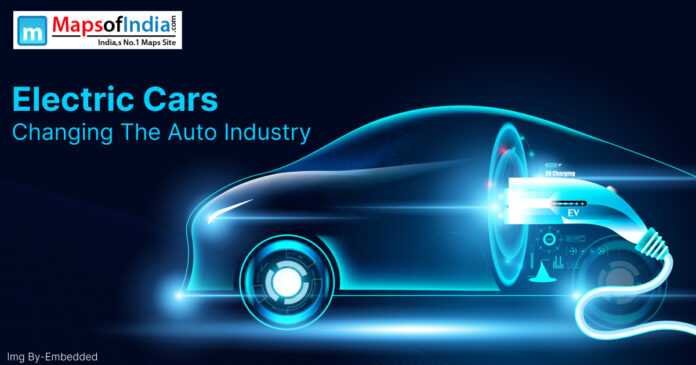Introduction
The popular use of internal combustion engines in cars is giving way to one of the industry’s biggest shifts ever. Electric vehicles (EVs) are leading the way and are quickly changing how we consider transportation, energy and environmental care. As technology advances and people’s tastes and ecological concerns increase, electric cars are becoming more popular and also transforming the process of making, selling, powering and controlling vehicles.
This blog examines the ways electric cars are transforming the way cars are made, sold, used and bought all over the world.
The Rise of Electric Vehicles
A Historical Perspective
It might surprise you to learn that electric vehicles have existed since the early 1800s. In the final years of the 1800s, EVs were similar in popularity to fuel-propelled cars. Hence, when Henry Ford’s Model T started mass production, gasoline cars partially displaced other vehicles to lead in the 20th century.
In recent years, worries about global warming, polluted air and the exhaustion of oil have fueled a return of electric vehicles. A break in battery technology, helpful policies and innovative action from Tesla have made what was once imaginable science fiction possible for everyone today.
EVs in the Modern Market
They have become a real choice for many people, not just a specialty for a few. In 2012, electric vehicles accounted for fewer than 0.5% of all cars sold around the world. Among countries as of 2024, the sector now has a share higher than 15%. EVs made up more than 80% of new car sales in Norway last year and China and the United States remain key countries for EV growth.
Environmental Impact and the Drive for Sustainability
Reducing Greenhouse Gas Emissions
One reason EVs are attracting more attention is that they may help lower greenhouse gas emissions. There is no tailpipe exhaust with electric cars like there is with internal combustion cars. Using energy-renewable resources such as wind or solar helps these vehicles have an even smaller effect on nature.
Transportation produces a lot of CO2 each year, making up close to quarter of the world’s total emissions. Adopting electric vehicles is a key contribution to reaching world climate targets and reducing global warming.
Lower Pollution and Health Benefits
They play a role in making city air cleaner. Cities experiencing bad air quality and smog will greatly improve by switching to electric vehicles. Thanks to EVs, the noise level in cities goes down, making it easier for residents to live there.
Air pollution kills about 7 million people prematurely, according to the World Health Organization. Reducing the use of fossil fuels is one way electric vehicles help enhance people’s health all over the world.
Disruption in Automotive Manufacturing
Simpler Mechanics, New Challenges
There is a big difference between electric cars and cars that use gasoline. There are less parts to move, they require little upkeep and they run on electric motors and not complex engines and transmissions. The simple design helps reduce both the costs of building the system and maintaining it later.
Still, it also impacts how parts and materials are traditionally delivered to automakers. Because ICE cars have fewer pieces, there are fewer roles for suppliers and less work in industries that support them. Also, new possibilities are now present in battery production, software development and parts adapted for EVs.
Legacy Automakers vs. New Players
The increasing use of electric vehicles has provided a chance for smaller companies to get in the game. Tesla, Rivian and Lucid Motors have faced off with established auto companies by presenting innovative features and selling cars to buyers directly.
Firms such as Ford, General Motors, Volkswagen and Toyota which have been building cars for decades, have had to move fast. Though many were cautious about switching at first, most have set out bold plans for electric vehicles. The F-150 Lightning from Ford, Ultium platform from GM and Volkswagen’s ID series are signs of the industry’s wider shift to electric technology.
Battery Technology: The Heart of the EV Revolution
Advances in Battery Chemistry
The battery is the most important part of an electric car. In the last decade, lithium-ion batteries have become easier to use, less costly and more dependable. Electric vehicles are becoming more popular because research on solid-state batteries makes them more energy efficient and offers faster charging times.
The cost of the battery is an important part of what makes a vehicle expensive. Because EV battery prices have gone down by more than 80% in the past decade, owning an electric car is easier for the average consumer. With improvements in technology, people will find that solar energy becomes even more affordable.
Recycling and Sustainability Challenges
The more EV vehicles are purchased, the larger the issues involving battery recycling and searching for raw materials become. The important metals lithium, cobalt and nickel for batteries might be environmentally harmful and ethically questionable to acquire.
Organizations and authorities are putting resources into closed-loop recycling and looking to decrease their use of rare resources. Researchers in the EV industry give top priority to creating better, more environmentally friendly batteries.
Charging Infrastructure and Energy Grid Integration
Building a Charging Network
A lack of charging stations can seriously slow the growth of electric vehicles. Governmental bodies and private entities are spending a lot on charging infrastructure to reduce the anxiety some people feel about their car batteries running out when no charger is available.
A typical EV battery can be charged to full within an hour by a DC fast charger or you can charge it at home overnight. Other automakers and third-party network operators became inspired by Tesla’s Supercharger network to improve their own charging services.
Grid Integration and Renewable Energy
Electric vehicles can help balance the electrical grid with V2G technology. This means they can give electricity back to the grid when a lot of people are using power. It helps keep the electricity steady and makes it easier to use clean energy like solar and wind.
When electric cars are charged using solar and wind power, the energy system becomes stronger and more eco-friendly. The combination of smart grid and AI systems is what helps unlock these synergies.
Changing Consumer Behavior and Market Trends
Shifting Preferences and Expectations
Current car buyers care more about the environment and technology than they ever have before. There’s more to electric cars than just being sustainable; people also like them for their modern features and how they drive.
Many EVs are praised for their fast torque, simple speed increase and stylish looks. Technologies such as autonomous steering, updates done wirelessly and big infotainment displays are suited to those used to smartphones and being online.
Cost of Ownership
Buying an electric car was more expensive in the past, but it usually costs less money overall than gas-powered vehicles. People with electric vehicles don’t have to pay as much for fuel, maintenance or repairs. The price gap becomes even smaller when we consider tax benefits, rebates and cheaper energy.
As batteries get more affordable and we make more, experts think EVs will be on par with gas-powered vehicles in most places by 2026 at the latest.
Autonomous Driving and Future Mobility
EVs and Self-Driving Technology
Electric vehicles are helping lead autonomous driving into the future. Because they are mainly digital, EVs can be more easily adjusted to new autonomous driving technology and sensors.
Tesla, Waymo and Cruise are building cars that can drive automatically in some situations. With further progress, these technologies ought to make urban travel easier, avoid many road accidents and make more transport available.
Mobility-as-a-Service (MaaS)
The rise of new transportation approaches largely depends on electric cars. More and more, car-sharing, ride-hailing and subscription services are switching to electric fleets. It means fewer cars are used which results in improved city transportation.
Low-emission areas, areas reserved for EVs and using electric scooters and bikes are ways cities are changing.
Challenges and Roadblocks Ahead
Supply Chain Disruptions
Despite moving forward fast, the EV revolution still hits some issues. Shortages of semiconductors and batteries have slowed down car production. The risks from tough geopolitical situations and limited resources might be seen in the future.
Consumer Misinformation and Skepticism
Even today, many consumers still doubt EVs because of false ideas that exist about the batteries, charging networks and how they handle poor weather. It is important to learn and understand these topics through experience and education.
Efforts by automakers and authorities should help people gain confidence in their products and the services provided.
Conclusion
They are more than a different sort of vehicle—they are leading the way in a major change in the auto industry. EVs are making it happen by lessening carbon emissions and improving the way we get around.
As this change takes place, the auto industry must keep innovating, spending and adjusting. Together, governments, automakers, consumers and tech companies will help change how we travel and will also do much good for our cities, our economies and the planet.









